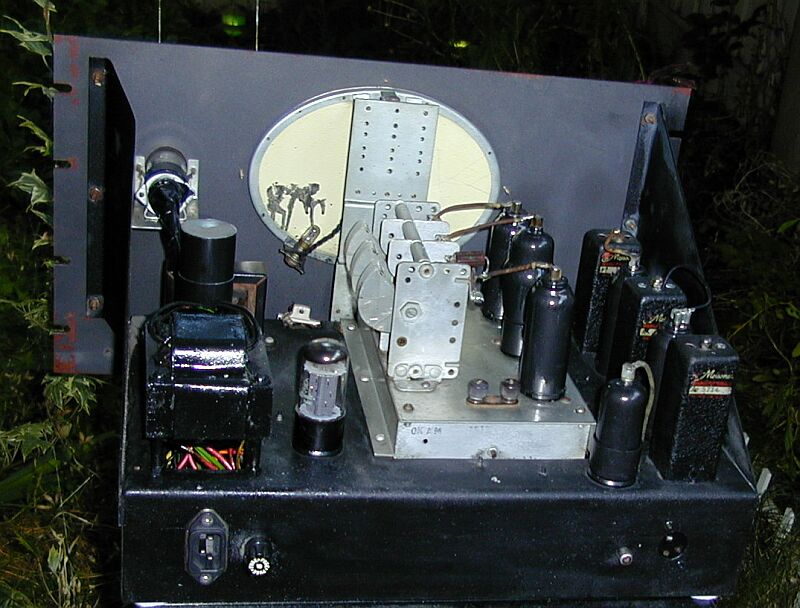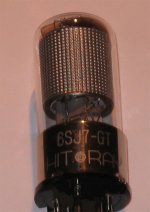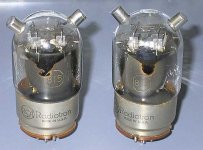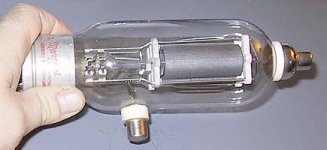Geek said:I'll be the turkey and say he has no one favorite tube
They will all be useful in something, at sometime.
At least that's the story I give my wife as she remeinds me of the space they're taking up
Yes I suppose tubes can take up a lot of valuable space. If you have 40,000 of them.
Hi Geek,
I have to agree with you there. Tubes were sold to different distributors and rebranded as needed. You have to look at the construction to know the actual maker. I do have some brands I do not like!
Hi wrenchone,
Japanese tubes were really good! They were well made and reliable. I wouldn't turn one down. They fall under NOS, I don't buy those unless the seller is realistic about their pricing.
-Chris
I have to agree with you there. Tubes were sold to different distributors and rebranded as needed. You have to look at the construction to know the actual maker. I do have some brands I do not like!
Hi wrenchone,
Japanese tubes were really good! They were well made and reliable. I wouldn't turn one down. They fall under NOS, I don't buy those unless the seller is realistic about their pricing.
-Chris
I'll be the turkey and say he has no one favorite tube They will all be useful in something, at sometime.
OK, I have about 1000 6AL5's. The only thing positive that I have found about these is the sound that they make when they hit the concrete wall. I also have several hundred 2D21's. They glow really cool when nuked in a microwave oven!
Yes I suppose tubes can take up a lot of valuable space. If you have 40,000 of them.
Sherri and I estimate that we have over 250,000 tubes. Most of them are weird stuff (WWII military surplus and odd filament voltage TV tubes). This requires 2000 cubic feet of warehouse space. Since the landlord recently raised the rent by 85%, some of them just have to go. When I get caught up on the amplifier boards, I will begin listing a lot of them on Ebay. The ones that don't sell will be tossed out.

Before anyone panics, there are NO rare audio tubes in the lot. They were already picked out before I got them. I am also saving anything that has a remote possibility of being used in audio.
My favorite unique tubes:
9002, previously mentioned 7 pin triode, very linear when loaded with a CCS.
6AV5GA, a small sweep tube. This comes in several flavors, some can reliably operate at twice the published ratings. They sound very good in SE and screen driven P-P.
6LW6, the best of the octal based sweep tubes. Rated for 40 watts of dissipation, it has no problems at 60 watts. 150 watts from a P-P pair without issue.
Most sweep tubes. The big pentodes (horizontal output) make good P-P output tubes, especially using screen drive. The dual dissimilar triodes (vertical output) make decent one tube per channel amps. There are also triode - pentode compactrons made for vertical output duty (6LU8, 6LR8, etc.) triode wire the pentode section to make a single tube per channel amp.
On the other hand, I have found that most tubes that were intended for agc controlled IF amplifiers are not linear enough for audio. If you find the sweet spot for a particular tube, it will not work well when you change tubes. The 6BA6 and 6SK7 come to mind, but this applies to most remote cutoff pentodes. If in doubt, break one open and look at the spacing of the control grid windings. If they are not evenly spaced, avoid using them.
As far as the Sovtek 5AR4's are concerned, I have come to believe that most Sovtek tubes have good batches, and bad batches. I have 4 Sovtek 5AR4's that have lived reliably in my 845Se amp where the operate in a voltage doubler off of a 480 volt industrial transformer that has a DCR of 25 ohms.
tubelab.com said:
Sherri and I estimate that we have over 250,000 tubes. Most of them are weird stuff (WWII military surplus and odd filament voltage TV tubes).
I've found WW-II tubes to be reliable like tanks, most of them measure still better than new. Odd filament voltages are convenient for hybrid amps.
6LW6, the best of the octal based sweep tubes. Rated for 40 watts of dissipation, it has no problems at 60 watts. 150 watts from a P-P pair without issue.
I like them too.
As far as the Sovtek 5AR4's are concerned, I have come to believe that most Sovtek tubes have good batches, and bad batches. I have 4 Sovtek 5AR4's that have lived reliably in my 845Se amp where the operate in a voltage doubler off of a 480 volt industrial transformer that has a DCR of 25 ohms.
It is easy to pick up factory rejects on eBay.
Speaking of remote cutoff penthodes, they are good for guitars (sound coloration) and for 1'st stage of mic preamps with compressor (differential pair, transformer coupled, variable bias).
Speaking of remote cutoff penthodes, they are good for guitars (sound coloration)
I discovered a really long time ago that you could get a cool sound from the old Fender Champs by swapping the 6SJ7 with a 6SK7, then drive the amp with a fuzz box (Vox Tone Bender).
I've found WW-II tubes to be reliable like tanks, most of them measure still better than new.
This seems to be true. I have a lot of vintage 807's and 1625's that work very well, except for the caps falling off. I have set asside all the transmitting tubes and small signal tubes for future experimentation. But what do you do with 500 pounds of HV rectifiers, grid controlled rectifiers, thyratrons and other late 40's vintage radar stuff?
tubelab.com said:
But what do you do with 500 pounds of HV rectifiers, grid controlled rectifiers, thyratrons and other late 40's vintage radar stuff?
Thyratrons may look beautiful on a chrome chassis surrounded by shiny wood.
Thyratrons MAY look beautiful on a chrome chassis surrounded by shiny wood.
Not these. These tubes were kept in warehouses in either Florida or Georgia. Neither warehouse was critter proof. The tubes were visited by rats (ate the boxes), pigeons (you know what pigeons leave behind) and rain. The crew hired to empty the warehouses was not kind to them either. I have found thousands of broken tubes. But on the other hand, I got them all in exchange for a couple of weekends work.
I have had to invent creative ways to clean the useful tubes.
It is easy to pick up factory rejects on eBay.
Sometimes their distributors sell them too!
tubelab.com said:
I have had to invent creative ways to clean the useful tubes.
Dishwasher?
Metal tubes look great hammer-painted (6S7 on the photo).

They are rated for 300V and about 5W of plate dissipation, but plate size is like 6AQ5
I tried the similar 6AU6 as a current source. The tube is rated for 3 watts of dissipation, but they behave badly above 2 watts.
The 6AQ5 is a different story. I have successfully melted the glass on a 6AQ5, while the tube was still working. It died when the vacuum sucked air through a hole in the melted glass. It positively rocked right up until it died. I have a few hundred of these (keepers) and have been exploring the useful operating limits. The old military GE 6005's seem to take the most abuse. These can make good sounding "mini Champ" style guitar amps. Gibson used them in some Skylark amps.
Dishwasher?
Yes, I have tried the dishwasher. The dishwasher detergent is too harsh on the pins, so use very little, keep the tubes from flying around (the wife doesn't like the texture of the broken glass on the silverware), and only try this on tubes that do not have a base (7 and 9 pin minis and compactrons). It will remove most of the painted lettering from the tubes also. I find that it is too much of a pain, so I gave that idea up. Trust me, don't put tubes in the clothes washing machine either, even in that little perforated bag. Broken glass shards in your jeans isn't much fun.
For valuable tubes, I have resorted to WD40 and a tooth brush for cleaning the pins, and a damp paper towel to remove as much of the crud as possible from the glass. For some tubes (Amperex Bugle Boys) I use a Q-tip and some windex to clean up the glass without getting any on the logo. The old paint will come off if you touch it with sweaty hands, or any chemicals.
Tubes like the 6AQ5's and others that are not particularly valuable can be cleaned up with WD40. All of the painted on logo will disapear, but the logos were already messed up. Then I clean the pins with the toothbrush, and use a pin straightener. Some of the tubes have badly corroded pins that break easily. These are used for some of my tube torture testing, and for experimenting with new ideas. If I melt one, who cares, I would have tossed it anyway.
but the 815 is sure cute
I have seen some of those two headed aliens in the warehouse, but I haven't tried any of them yet. I have also found a smaller sibling the 7193 (I think). It is a two headed octal alien, with 6J5 guts inside.
tubelab.com said:
OK, I have about 1000 6AL5's. The only thing positive that I have found about these is the sound that they make when they hit the concrete wall.
I can imagine *pock* you passing *pock* time in the *pock* hurricane shelter *pock*
/me thinks you would have fun with a BB gun
The 2D21 thyratron tubes don't have any use at all in standard audio circuits, but they are very handy for in oscillator and divider circuits if you want to make a wicked analog synthesizer. Apparently the 2D21 is remarkably stable as a relaxation oscillator, and doesn't budge even if you play a propane torch on it.
- Status
- This old topic is closed. If you want to reopen this topic, contact a moderator using the "Report Post" button.
- Home
- Amplifiers
- Tubes / Valves
- Favorite Tubes
 .
.

